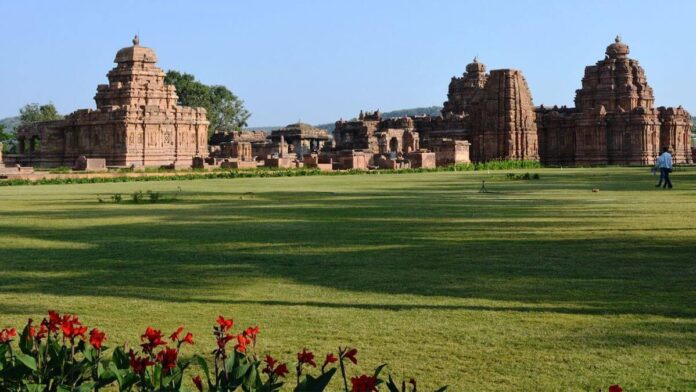India is a land of rich cultural and religious diversity, with a history that spans thousands of years. One of the most prominent aspects of this heritage is its ancient and medieval temples, which stand as architectural marvels and sacred sanctuaries.
These temples, built by various rulers and dynasties, offer a glimpse into India’s spiritual and artistic evolution. In this article, we will explore 20 major ancient and medieval temples in India, highlighting the rulers and the approximate years of their construction.
- Kailasa Temple, Ellora (8th Century) Ruler: Rashtrakuta King Krishna I The Kailasa Temple, carved out of a single rock, is an astonishing example of ancient Indian architecture. It is dedicated to Lord Shiva and represents Mount Kailash, his celestial abode.
- Khajuraho Group of Monuments, Madhya Pradesh (10th-11th Century) Rulers: Chandela Dynasty The Khajuraho Group of Monuments is renowned for its intricate erotic sculptures and stunning architecture. It is a UNESCO World Heritage Site.
- Brihadeeswarar Temple, Thanjavur (11th Century) Ruler: Chola King Raja Raja I This temple is a masterpiece of Dravidian architecture and is dedicated to Lord Shiva. It is also known as the Big Temple and is a UNESCO World Heritage Site.
- Sun Temple, Konark (13th Century) Ruler: King Narasimhadeva I of the Eastern Ganga Dynasty The Sun Temple in Konark is shaped like a chariot with 24 intricately carved wheels. It is dedicated to the Sun God, Surya.
- Meenakshi Amman Temple, Madurai (17th Century) Ruler: Nayak Dynasty The Meenakshi Amman Temple is dedicated to Goddess Meenakshi and Lord Sundareswarar. It is known for its stunning architecture and colorful sculptures.
- Golden Temple, Amritsar (17th Century) Ruler: Guru Arjan Dev, the 5th Guru of Sikhism The Golden Temple, also known as Harmandir Sahib, is the holiest site in Sikhism. Its gilded exterior and serene surroundings attract pilgrims from around the world.
- Badami Cave Temples, Karnataka (6th Century) Rulers: Chalukya Dynasty The Badami Cave Temples, carved out of sandstone hills, are dedicated to various Hindu deities. They are renowned for their intricate carvings and architecture.
- Jagannath Temple, Puri (12th Century) Ruler: King Anantavarman Chodaganga Deva The Jagannath Temple is dedicated to Lord Jagannath, an incarnation of Lord Vishnu. The annual Rath Yatra, or chariot festival, is a famous event associated with this temple.
- Ranakpur Jain Temple, Rajasthan (15th Century) Ruler: Rana Kumbha of Mewar The Ranakpur Jain Temple is a magnificent example of Jain architecture, with 1,444 intricately carved marble pillars. It is dedicated to Lord Adinath.
- Kedarnath Temple, Uttarakhand (8th Century) Ruler: Adi Shankaracharya The Kedarnath Temple, nestled in the Himalayas, is one of the Char Dham pilgrimage sites dedicated to Lord Shiva. It is known for its stunning natural beauty.
- Chennakesava Temple, Belur (12th Century) Ruler: King Vishnuvardhana of the Hoysala Dynasty The Chennakesava Temple is celebrated for its intricate sculptures and is dedicated to Lord Vishnu.
- Ramanathaswamy Temple, Rameswaram (12th Century) Ruler: Pandya Dynasty The Ramanathaswamy Temple is one of the twelve Jyotirlinga shrines and is dedicated to Lord Shiva. It features a long corridor with 1,212 intricately carved pillars.
- Hoysaleswara Temple, Halebidu (12th Century) Ruler: Hoysala King Vishnuvardhana The Hoysaleswara Temple is famous for its intricate and detailed sculptures, showcasing various mythological stories.
- Sanchi Stupa, Madhya Pradesh (3rd Century BC) Ruler: Emperor Ashoka The Sanchi Stupa is a significant Buddhist monument with intricate carvings and an iconic hemispherical dome. It is a UNESCO World Heritage Site.
- Virupaksha Temple, Hampi (7th Century) Ruler: Various dynasties, including the Vijayanagara Empire The Virupaksha Temple is dedicated to Lord Shiva and is located in the historic city of Hampi, a UNESCO World Heritage Site.
- Dwarkadhish Temple, Dwarka (16th Century) Ruler: Raja Jagat Singh of Kutch The Dwarkadhish Temple is dedicated to Lord Krishna and is believed to be located at the place where Lord Krishna’s city of Dwarka once stood.
- Ellora Cave Temples, Maharashtra (5th-10th Century) Rulers: Various dynasties, including the Chalukyas and Rashtrakutas The Ellora Cave Temples are a complex of rock-cut temples representing Hindu, Buddhist, and Jain faiths. They are a UNESCO World Heritage Site.
- Shri Jagat Shiromani Temple, Amer (17th Century) Ruler: Raja Man Singh I of Amer The Shri Jagat Shiromani Temple is dedicated to Lord Krishna and Radha. It is known for its exquisite marble work and stunning architecture.
- Chidambaram Nataraja Temple, Tamil Nadu (12th Century) Ruler: Chola Kings, including Rajaraja I and Rajendra I The Chidambaram Nataraja Temple is dedicated to Lord Shiva in his dancing form as Nataraja. It is famous for its unique representation of Lord Shiva’s cosmic dance.
These ancient and medieval temples not only showcase India’s diverse religious traditions but also reflect the artistic and architectural prowess of the rulers and dynasties that patronized them.
They are living testaments to the spiritual and cultural heritage of India, drawing visitors and pilgrims from all corners of the world.
As they continue to stand the test of time, they serve as a link between the past and the present, connecting us to the rich history and traditions of this incredible country.
